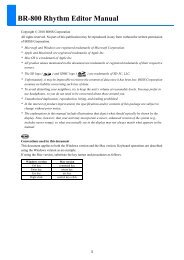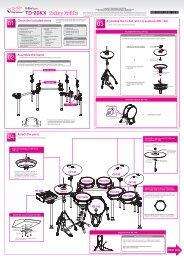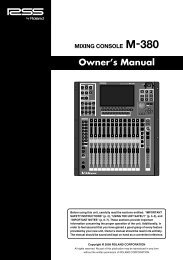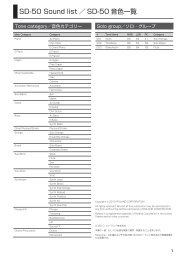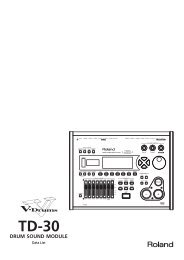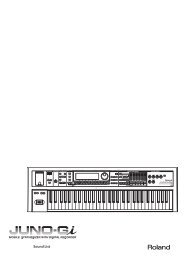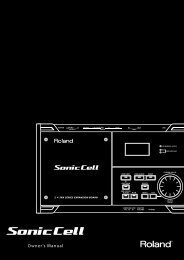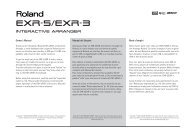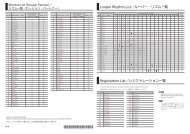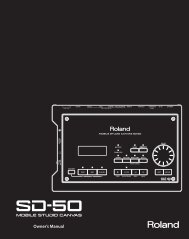GAIA Exploring Sound (PDF) - Roland Corporation Australia
GAIA Exploring Sound (PDF) - Roland Corporation Australia
GAIA Exploring Sound (PDF) - Roland Corporation Australia
Create successful ePaper yourself
Turn your PDF publications into a flip-book with our unique Google optimized e-Paper software.
Now for the body of the Electric Piano sound.<br />
Select TONE 3 and follow the Action List in Figure 11.5.<br />
metallic sound more when played louder. You could further<br />
emphasize this condition by slightly raising the Velocity Sensitivity<br />
of TONE 3.<br />
Figure 11.5 EP TONE 3<br />
Again, there is much to be<br />
learnt from this new recipe.<br />
If you now play this sound you will find we have a convincing<br />
Electric Piano sound, although it does sound a bit low in pitch.<br />
We have chosen a particular<br />
Pulse waveform, the one that<br />
sounds most like an electric<br />
piano. Of course, you are<br />
welcome to try any other<br />
waveform.<br />
The Oscillator is tuned down<br />
one octave. A very deliberate<br />
choice. It has allowed us to put<br />
a greater “distance” between<br />
the tuning of the body (TONE<br />
3) and the metallic sound (TONES 1 & 2).<br />
We have used the inverted Filter Envelope again in order to<br />
emphasize that metallic dampening we used in TONE 1 and 2.<br />
One further point about TONES 1 & 2; we lowered the Velocity<br />
Sensitivity. This was done because the original Electric Piano<br />
would sound more metallic when played softly. So if we limit the<br />
velocity sensitivity of the metallic sound, but maintain full velocity<br />
for the body, then TONE 3 will effectively begin to mask the<br />
Try raising the pitch by pressing the Octave Up button once.<br />
Now to further enhance this sound let’s add some effects that<br />
were typically used on Electric Pianos of the time.<br />
Switch on the Phaser, the Reverb, and lower the Reverb Level to<br />
about 10.<br />
It’s that simple! You now have a synthesized version of an Electric<br />
Piano.<br />
Perhaps it’s not an exact copy, but more than anything it has<br />
allowed us to illustrate a few of the more advanced Subtractive<br />
Synthesis techniques.<br />
You may have noticed that we only switched on the Phaser effect.<br />
We made no attempt to modify the Phaser parameters. The Initial<br />
Patch provided something quite appropriate.<br />
In general, you will find that a lot of thought has gone into creating<br />
the Initial Patch. However, feel free to adjust the effect parameters to<br />
suit your taste.<br />
148




